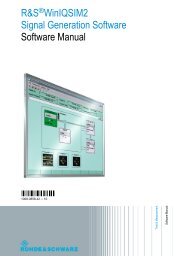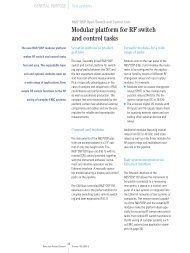News from Rohde&Schwarz - Rohde & Schwarz
News from Rohde&Schwarz - Rohde & Schwarz
News from Rohde&Schwarz - Rohde & Schwarz
You also want an ePaper? Increase the reach of your titles
YUMPU automatically turns print PDFs into web optimized ePapers that Google loves.
Final article<br />
IT security is another area of application<br />
for random numbers. In this rapidly<br />
growing business field, professional<br />
solutions are offered by SIT Gesellschaft<br />
für Systeme der Informationstechnik<br />
mbH, a subsidiary of <strong>Rohde</strong> &<br />
<strong>Schwarz</strong>. Through the use of bit sequences<br />
that cannot be predicted,<br />
techniques have been established that<br />
are now indispensable:<br />
Encryption methods use secret<br />
keys and other parameters produced<br />
by a random generator to<br />
make them unpredictable for nonauthorized<br />
persons. For instance,<br />
SIT products offer solutions both in<br />
hardware and software that generate<br />
random bit sequences for<br />
encryption parameters (keys and<br />
initialization values).<br />
With the digital signature it is<br />
similar. If a potential attacker<br />
knows the rule for generating<br />
keys, he has a better chance of<br />
cracking the code and forging<br />
signatures.<br />
With socalled challenge response<br />
protocols used for authentication,<br />
a potential attacker can adapt to<br />
it and prepare for the correct response<br />
if some challenges occur<br />
very frequently.<br />
Random bit sequences used for<br />
stream ciphers or frequency hopping<br />
are normally not directly<br />
generated in a random way but<br />
derived indirectly <strong>from</strong> a randomly<br />
generated secret key. But these<br />
derived sequences must show<br />
statistical characteristics similar to<br />
those of randomly generated bit<br />
sequences. In particular, the sequence<br />
bits should not be predictable<br />
without knowledge of the<br />
secret key.<br />
How are random numbers<br />
generated?<br />
Random numbers used for the mentioned<br />
applications can be generated<br />
in a variety of ways apart <strong>from</strong> throwing<br />
dice or tossing a coin.<br />
Many programming languages contain<br />
a function for generating random<br />
numbers. Numerals with statistical<br />
characteristics similar to those of random<br />
figures are generated <strong>from</strong> the<br />
system clock of the computer and <strong>from</strong><br />
entered parameters. These values are<br />
mostly sufficient for simulation programs<br />
and Monte Carlo calculations,<br />
but unpredictability and other crypto<br />
requirements are only met to a limited<br />
extent. One reason for this is that a<br />
year has “only” about 31.5 million<br />
seconds and such a number is quickly<br />
checked through on a modern PC.<br />
An interesting method is used by the<br />
e-mail encryption software PGP (pretty<br />
good privacy): the user is asked to<br />
strike any sequence of keys on the<br />
keyboard for generating a random<br />
parameter. After the character sequence<br />
has been processed in a complicated<br />
conversion process, the criterion<br />
of unpredictability should be met.<br />
Other solutions have to be found however<br />
if a great number of random<br />
parameters is needed and/or the encryption<br />
keys should be generated independently<br />
of the persons involved.<br />
Effective and secure generation of random<br />
numbers is also very important<br />
when implementing the laws regarding<br />
electronic signatures.<br />
Various physical phenomena may be<br />
used as a basis in generators producing<br />
random bit sequences. One example<br />
is the noise characteristics of<br />
Zener diodes. By processing these<br />
noise signals, bit sequences can be<br />
generated that are unpredictable and<br />
have “ideal” statistical characteristics.<br />
The next issue will look at statistical<br />
criteria for assessing the quality of randomly<br />
generated bit sequences.<br />
Dr Ralph Wernsdorf<br />
Reader service card 164/26<br />
REFERENCES<br />
– R. Zielinski: Erzeugung von Zufallszahlen.<br />
Fachbuchverlag Leipzig, 1978.<br />
– P.H. Müller (Hg.): Lexikon der Stochastik,<br />
Akademie-Verlag Berlin, 1991.<br />
– R. Wobst: Abenteuer Kryptologie. Addison-<br />
Wesley, 1998.<br />
<strong>News</strong> <strong>from</strong> <strong>Rohde</strong> & <strong>Schwarz</strong> Number 164 (1999/IV) 39

















